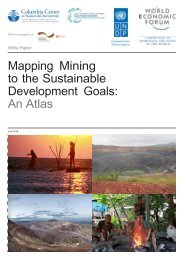Mining matters Natural resource extraction and local business constraints
2fCPiMQ
2fCPiMQ
You also want an ePaper? Increase the reach of your titles
YUMPU automatically turns print PDFs into web optimized ePapers that Google loves.
We test this hypothesis by combining two main data sets. First, we use detailed data on<br />
22,150 firms from the EBRD-World Bank Business Environment <strong>and</strong> Enterprise Performance<br />
Survey (BEEPS) <strong>and</strong> the World Bank Enterprise Survey. These data contain the responses of<br />
firm managers to questions on the severity of various <strong>constraints</strong> to the operation <strong>and</strong> growth<br />
of their <strong>business</strong>, including access to transport infrastructure, electricity, l<strong>and</strong>, educated workers<br />
<strong>and</strong> finance. A growing literature uses such survey data to gauge whether access to various<br />
public goods affects firm performance. 2 Firms’ perceptions of the relative importance of<br />
different external <strong>constraints</strong> on their activity can be useful to learn about which <strong>constraints</strong><br />
affect economic activity the most (Carlin, Schaffer <strong>and</strong> Seabright, 2010). These constraint<br />
variables also measure competition for inputs directly as they reflect firms’ intended rather than<br />
actual use of inputs. We therefore exploit variation across firms in the reported severity of<br />
external input <strong>constraints</strong> to assess how <strong>local</strong> mining activity, by congesting the quality <strong>and</strong><br />
quantity of public input provision, affects the ability of <strong>local</strong> firms to grow.<br />
Second, we use the proprietary SNL Metals & <strong>Mining</strong> data set, which contains<br />
comprehensive information on the geographical location, operating status <strong>and</strong> production data<br />
for individual mines. We identify the latitude <strong>and</strong> longitude of 3,793 mines producing 31<br />
different metals <strong>and</strong> minerals in our country sample. Depending on the year, we observe the<br />
operating status of between 1,526 <strong>and</strong> 2,107 mines.<br />
Merging these firm <strong>and</strong> mine data allows us to paint a precise <strong>and</strong> time-varying picture of<br />
the mines that open, operate <strong>and</strong> close around each firm. Since <strong>local</strong> mining activity is plausibly<br />
exogenous to the performance of individual firms—as it largely depends on <strong>local</strong> geology <strong>and</strong><br />
world mineral prices—we can identify the impact of mining on <strong>local</strong> <strong>business</strong> <strong>constraints</strong> <strong>and</strong><br />
firm performance. To the best of our knowledge, ours is the first paper to estimate this impact<br />
of mining activity on firm performance across a variety of countries.<br />
Two core results emerge from our analysis, both consistent with a sub-national version of<br />
the seminal Corden <strong>and</strong> Neary (1982) model. First, in line with a “<strong>resource</strong>-movement effect”,<br />
we uncover heterogeneous mining impacts in the immediate vicinity (≤ 20 kilometers) of active<br />
mines that depend on whether a firm produces tradeable or non-tradeable goods. Only producers<br />
2<br />
See, for instance, Comm<strong>and</strong>er <strong>and</strong> Svejnar (2011) <strong>and</strong> Gorodnichenko <strong>and</strong> Schnitzer (2013). Appendix B<br />
contains the questions we use in this paper <strong>and</strong> www.enterprisesurveys.org provides additional background<br />
information. The surveys also provide a rich array of firm covariates, such as their industry, age, sales,<br />
employment, <strong>and</strong> ownership structure.<br />
2






